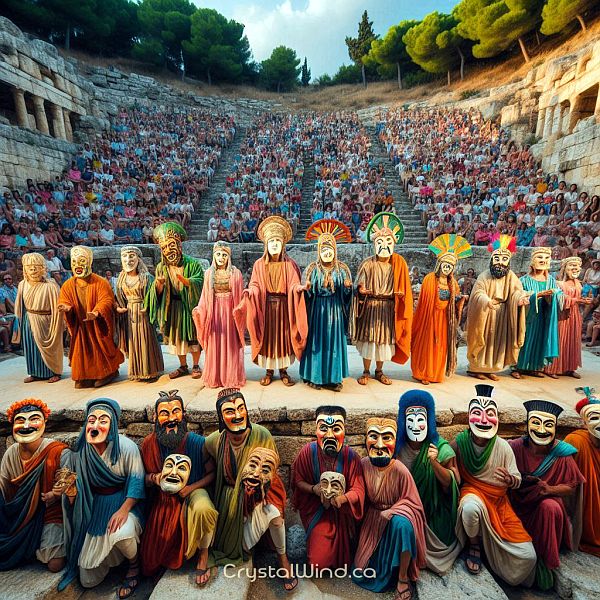Ancient Rituals and Theater: The Power of Catharsis Revealed
- Details
- Written by Marcela Lobos

Alberto and I just completed an exploratory journey to our Western sacred origins in Greece.
One of the topics we dove into was theater as an ancient healing medium that would bring about catharsis—an emotional and psychological purification.
From 600 BC a theatrical culture flourished in Athens spreading to its numerous colonies. It began as part of an ecstatic festival honoring the god of wine, fertility and sacred rituals. These early performances evolved from choral hymns celebrating Dionysus and over time developed into more complex forms of drama involving dialogue, individual characters, and elaborate narratives.
According to the philosophical, political and religious needs of the times, three forms of theater emerged: tragedy, comedy and satire.
Tragedy: portraying suffering, fate, divine intervention, and moral dilemmas, allowed the audience to reflect on the darker aspects of human existence. Tragedies were centered on noble or heroic characters who faced inevitable sorrow or downfall due to a combination of personal flaws and external forces such as fate or the gods’ will. The protagonists were often caught in morally complex situations, and their struggles reflected broader concerns about justice, the role of the gods, and the limits of human understanding. A famous example is the story of Oedipus who unknowingly kills his father and then marries his mother.
Comedy: was a lighthearted reflection on society. It was a humorous depiction of contemporary life, social norms, and politics. An example is in Lysistrata, where women band together to withhold sex from their husbands to force them to end the Peloponnesian War, offering a comical yet pointed commentary on war and gender relations. After a decline of this political humor, the focus was transferred to more domestic topics and romantic entanglements.
Satire: was a blend of tragedy and comedy, of the serious and the absurd, providing comic relief after the solemn tragedies presented at dramatic festivals. These plays were named after their chorus, which consisted of satyrs, half-man, half-goat creatures associated with Dionysus. Satire plays were characterized by their bawdy humor and playful sexual innuendos. While still engaging with the same mythological material as the tragedies, they mocked their heroes, offering a relief from the seriousness of the tragical drama. For instance, Euripides’ satire depicts the hero Odysseus in a comedic interaction with the Cyclops, in contrast to the more heroic Odysseus in Homer’s account.
These forms of theater were entertaining but also were meant to create a collective catharsis—an emotional cleansing. In watching the disgrace of noble characters like Oedipus, the audience experienced intense feelings of pity and fear that such a fate could befall anyone. In this way, ancient theater was enormously healing for the social group. It allowed for deep existential drama to be acted out, leaving the audience with a sense of balance and moral clarity by the end of the performance.
Thus, in ancient Greece, theater was an art form where the audience, primarily composed of male citizens, could engage in a shared emotional and intellectual experiences, reinforcing the values of the polis. But what about the women? I am pretty sure that at the root of the Dionysian festivals were women’s cults to Mother Nature and the Goddess (this could be a blog for another time).
While in the exploration of our Greek theatrical roots, Alberto and I summoned Dionysius to free us from any self-conscious fear or care, and we encouraged each person in our travel group to put their own drama on stage for the sake of catharsis. It was a very liberating experiment that brought us closer together and allowed us to appreciate newly this ancient form.
Have you ever tried to play-out the very painful stories or funny tales that your mind spins?
Marcela Lobos
Posting on CrystalWind.ca ©2024. All rights reserved. Please do not reproduce any content without written permission. The article's title was crafted by CrystalWind.ca.
Liked this article? Dive deeper into personal growth and wellness! Check out CrystalWind.ca for spiritual wisdom or explore AromaWorx.ca for natural well-being tips. Spread the positivity—share this with friends on their happiness journey!
Let’s Chat! Drop Your Thoughts Below! ![]()
Latest Articles
Dive into the Mystical World of the Crystal Wind Oracle Deck!
Get All the Enchanting Details Now!
NEW Expanded Boxed Edition!
Now with 58 Cards for Richer Wisdom!

Imagine a world of inspiration and healing, free for all—made possible by YOU!
Donate Now—Ignite the Magic at CrystalWind.ca!

Epilepsy - Finding A Cure
Your donation can make a difference!
Help us find a cure – donate now!
Unlock Your Light: Join Lightworkers Worldwide on CrystalWind.ca!
Follow Us!
Featured This Month
Egyptian Zodiac/Astrology
Egyptian astrology was one of the earliest forms of astrology. The Egyptians w... Read more
Cancer Mythology
The Mythology of Cancer: A Celestial Tale of Loyalty and Sacrifice Among th... Read more
Lugh - Celtic God Of The Sun
The god Lugh was worshiped in Ireland as a deity of the sun. This connection... Read more
Sun in Cancer
Cancer Sun Sign Characteristics Overview The name "Cancer" comes from Latin, ... Read more
Abalone Shell
Echos Of The Ancestors Abalone strengthens the structure of the body and th... Read more
Chalcedony
The Stone Of Orators Chalcedony was very popular as a decorative stone in ant... Read more
Lammas by The Hedgewitch
Although in the heat of a Mid-western summer it might be difficult to discer... Read more































































































































































